Convection in a box
J.L. Henshaw (aka P.F.)- experiments in 1978, Denver
Other Airwork,
1999 2003 These are intriguing convection experiments with smoke
that can be performed using a Plexiglas box and a burning stick of incense.
I used solvent glue to make 6"x6" boxes of varying depth, using 1/8"
Plexiglas
on the faces and 1/16" Plexiglas on the edges, making gaps in the edge
pieces for openings as needed. Several observed behaviors
pose
challenging questions. Click on the pictures for image
pop-ups. Have fun.
- A single 2D vortex ring - displaying
apparent contradictions
- Detailed diagrams of vortex flow - the
winding &
wrapping of layers
- Smoke pool - with branching columns of
clear air
- Very strange indeed - a clear
confusion
between
up and down
One thing these experiments demonstrate is Organized
Molecular Motion
, fluid states that store and release energy. This
is clearly evident from experiment 4, and then can help explain
experiments 1, 2 & 3. There is a simpler way to perform
experiment 4 that usually works. On a table in a quiet
place stand a burning cigarette on its end and patiently
watch. After a while smoke will be seen pouring down the
outside to form a pool of smoke around the base. Wisps will
then sometimes be seen spontaneously rising from the smoke pool, storage and
release, QED. Perhaps several repetitions will be
needed for you to believe what you see.
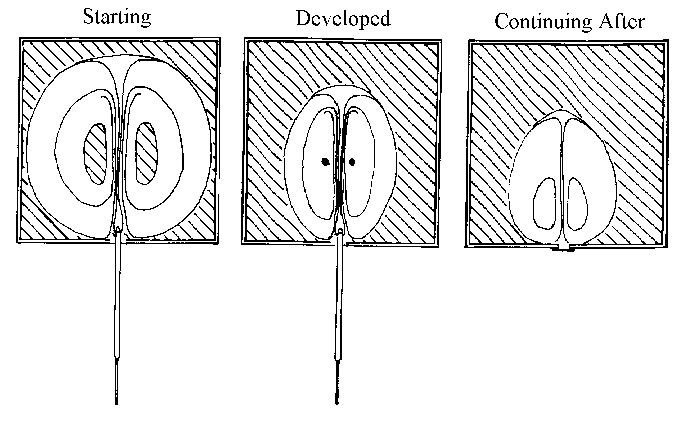 |
With
an opening in the bottom of a ~1/4" deep box, a burning incense stick
is
inserted and the rising smoke generates a convection
loop.
At first the flow may look like a large circle, two 'D' shaped spirals
back to back, nearly filling the chamber (left). Curiously
the none of the smoke rises to spread out at the top.
After a few seconds, with a continuing introduction of heat and smoke,
the double spiral curiously becomes smaller and denser
(center).
Both of these behaviors seem wrong when you think about
them.
First, the smoke should rise and spread out at the top, like in open
air,
but it doesn't. Second the vortex should get larger the
more
heat and smoke are added, not smaller. After removing the incense
stick and covering the hole in the bottom of the box the 2D
vortex
ring continues, firmly sitting on the bottom of the box (right).
|
| |
|
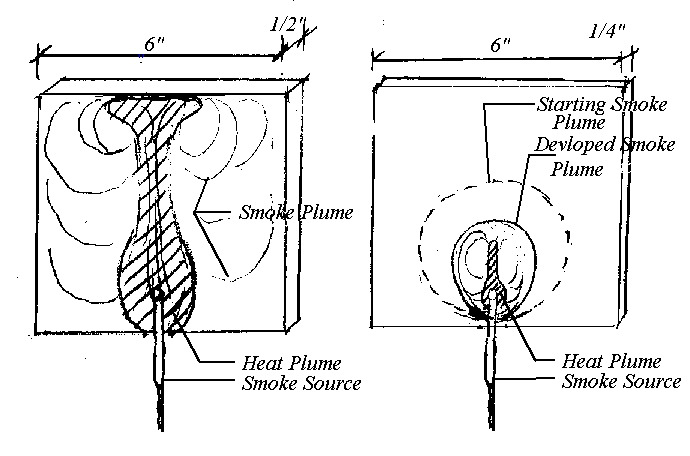 |
When
you try it with a 1/2" deep box the self-confined cell does not
develop.
Smoke goes to the top and spreads out (in a 6"x6" box at least) just
like
you'd expect it to. The image at the left shows a
recent
test of both 1/2" and 1/4" depth containers, and using color changing
heat
sensitive film on the back surface, to help show where the heat
goes.
In the 1/4" box, the heat introduced almost seems to disappear.
Of
course it does not, but there is an increase in density in the confined
smoke cell and no indication of a corresponding heat loss.
There are surely other things to be resolved too, but I think this is
unambiguous
evidence of fluid-partical gels. That could explain why something
hot acts heavy, a problem observed in all these studies. The key
observation is that the smoke comes to circulate entirely within
itself.
The rising plume flows down from above and is then drawn in at the
bottom
and up at the center. It's possible to interpret this as smoke
being
pulled downward on the outside by the central current. A
possibly
important observation is that in an 1/8" deep box the smoke cell that
forms
is about the size of a quarter, very small, and the circulation is so
confined
that the incense stick is snuffed out almost immediately.
In
the 1/4" deep box the ember can go out for lack of oxygen as well,
though
not for some time. |
What's wrong with the idea suggested by some,
that
the walls drain enough heat from the smoke to make it heavier than air,
is that :
1) the effect increases over time, rather than slowing as the walls
get hotter, and
2) the smoke would spread out over time, not compress, seeking the
cooler portions of the surface
3) Plexiglas has a very low specific heat and the smoke is not in
circulating
contact with it.
Others have suggested that it's just the
proximity
of vertical surfaces. If the same smoke source is held close to a
similar surface in quiet open air, smoke is seen easily drifting upward
even within the near ('sticky' ~1/32") boundary layer where all flow is
laminar. The proximity of the surface alone is not what makes the
smoke turn and go down, but proximity must have something to do with
it,
since proximity is a controlling variable.
After removing the incense stick and covering
the
hole at the bottom the 2D vortex ring settles into the shape at
the
right, similar to an apple upside down. This continues
without
outwardly changing shape or size for a very long time. It
seems
to just spiral slower and slower until the smoke particles settle to
the
bottom of the chamber.
top
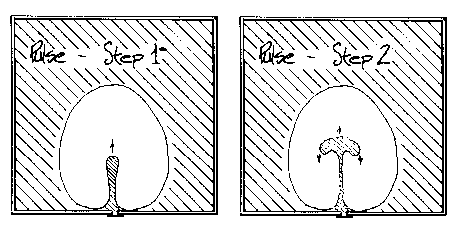 |
The
details of the spiral path of circulation can be seen after generating
a double spiral, removing the smoke source, and covering the bottom
hole.
Briefly removing the cover on the bottom hole introduces a pulse of
clear
air to be drawn up into the convection vortex and trace the circulation
shape..
|
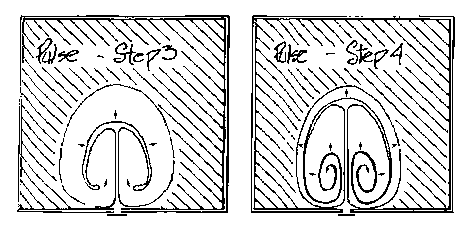 |
The
actual movement of the layers is quite simple, after moving up the
center
and splitting at the top the new material begins an infinite regression
of stretching and wrapping around itself while also migrating outward
toward
the outer surface. Material from the outer surface may then be
drawn
back in the bottom to start the process over. At first it
looks
like circular motion, but it is composed entirely of winding.
|
top
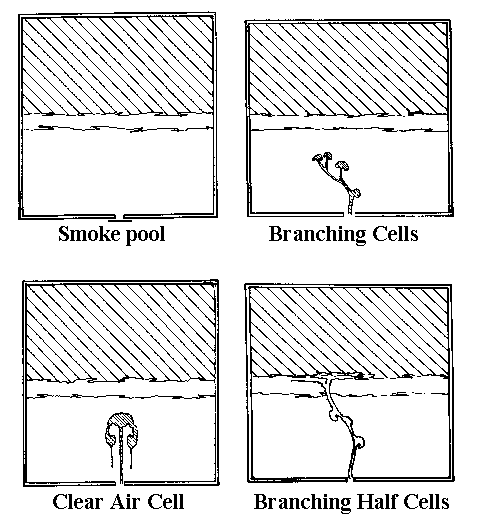 |
Some
interesting shapes result from blowing smoke into the box.
Do it gently so as not to mix it by forced turbulence. Then
momentarily
open a hole in the bottom to let in cool room air. Oddly,
the
smoke sits on the bottom and the 'cool' air rises through it,
displaying
a number of fascinating circulation patterns.
|
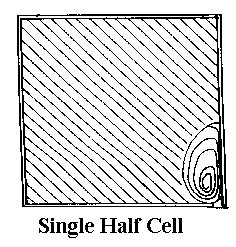 |
Introducing
an incense stick near the edge of the 1/4" deep box stimulates a single
'D' shaped loop, with the same characteristics as the more normal
double
'D' shaped shrinking convection cell. After removing
the incense stick and watching it sit there spinning by itself, crammed
into the corner instead of spreading out either along the top or
bottom,
seems very strange!
|
top
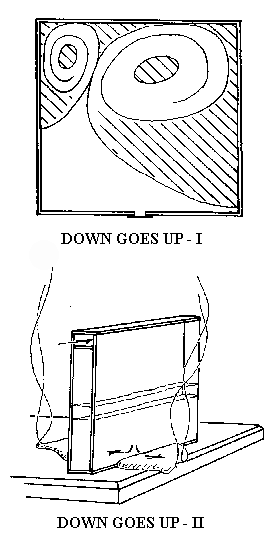 |
One
of the strangest things found were these two examples of 'heavy smoke'
spontaneously becoming buoyant. In both cases warm smoke
was
blown into the boxes gently so as not to turbulently mix, and was found
to first settle in a pool on the bottom. In the first
example
the box was then sealed and left alone. In the second,
openings
were made at the top and bottom, in completely still surroundings, and
the smoke was allowed to gently drain out the bottom with room air
entering
at the top.
The circulation shown in the first example
developed
after a few minutes. Instead of remaining motionless the
smoke
pool took on the shape shown, oddly sloped, necking upward on one side
and flowing toward the top of the box in a loose, lopsided, double
spiral.
There are quite a long list of things wrong with this one!
What explains both this and the following example seems impossible,
energy
storage and release in a fluid in some form other than heat.
In the second example the smoke pool in the
box
flows gently out over the table surface. It forms a thick
spreading
film as if a puddle of syrup. On occasion (~1/10 or
so),
and clearly only when the room air is quite still, little vigorous
rising
currents develop. They're not normal convection cells, but
twisting slivers of smoke. Warm smoke should not have settled in
a pool in the first place, and especially not spontaneously rise again
from it.
|
Back to top
, Other Airwork, Contact
Open Systems Physics
(Overview & perspectives) Physics of happening
(early methods and applications)

